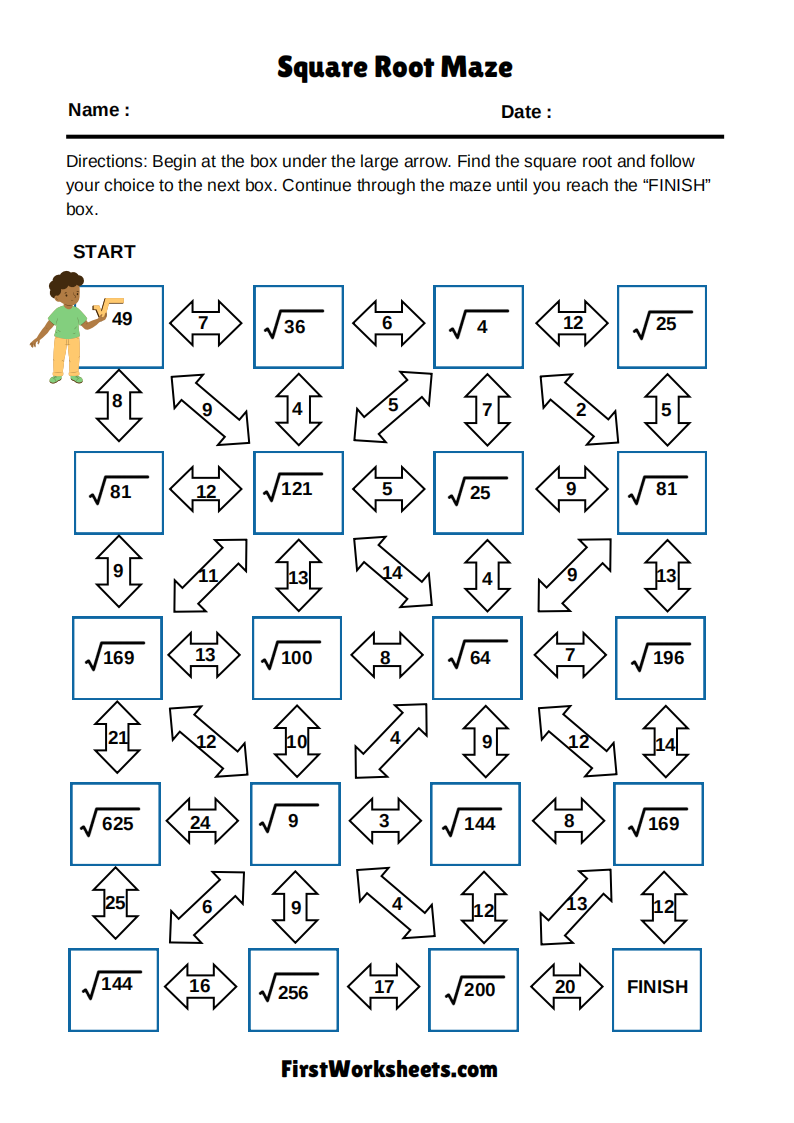Estimating Square Roots Worksheets
Square roots are a fundamental concept in mathematics, particularly in algebra and geometry. Understanding how to estimate square roots is crucial for students as it lays the foundation for more advanced topics such as quadratic equations, trigonometry, and calculus. To aid in this learning process, estimating square roots worksheets are invaluable tools that help students develop both intuition and skill in approximating square roots. This article will delve into the details of these worksheets, their importance, types of exercises included, and how they can be effectively used in educational settings.
Importance of Estimating Square Roots
Square roots are the inverse operation of squaring a number. For instance, the square root of 25 is 5 because 5² = 25. However, not all square roots are whole numbers; for example, √2 is an irrational number, approximately 1.414. Estimating square roots becomes essential when dealing with non-perfect squares (e.g., √3, √5, etc.), where exact values cannot be easily determined without a calculator.
Understanding how to estimate square roots helps students:
- Develop Number Sense: Estimating square roots requires a solid grasp of numbers and their relationships. Students learn to identify which two perfect squares a number lies between and use that to approximate the square root.
- Prepare for Higher-Level Math: Many algebraic and geometric problems involve square roots. A strong ability to estimate square roots simplifies these problems, making it easier to progress to more complex concepts.
- Improve Problem-Solving Skills: Estimating square roots is not just about finding an answer; it’s about using logical reasoning and approximation techniques, which are critical skills in mathematics.
Types of Exercises in Estimating Square Roots Worksheets
Estimating square roots worksheets typically include a variety of exercises designed to challenge students at different levels of proficiency. Here are some common types of exercises:
- Basic Estimation: These exercises focus on helping students identify which two perfect squares a number lies between. For example, students might be asked to estimate √10. They would recognize that 10 lies between 9 (3²) and 16 (4²), so √10 is between 3 and 4.
- Refined Estimation: Once students are comfortable with basic estimation, worksheets might include exercises that ask for a more refined estimate. For instance, estimating √10 to one decimal place. Knowing that √10 is closer to 3.16 than 3.1 requires students to think more critically about the proximity of 10 to 9 and 16.
- Comparison Exercises: These worksheets might include problems where students must compare the square roots of different numbers and determine which is larger. For example, comparing √50 and √55 without a calculator encourages students to estimate and compare based on their knowledge of square roots.
- Word Problems: Applying square root estimation in real-world contexts is another effective exercise. Word problems might involve situations where students must estimate square roots to solve practical problems, such as finding the diagonal length of a square or estimating distances.
- Multiple Choice Questions: These can help in reinforcing the concept by providing options for the estimated value of square roots. For example, students might be asked to choose the best estimate for √20 from options like 4.4, 4.5, and 4.6.
- Error Analysis: Worksheets may include problems where students analyze and correct errors in estimations provided by others. This helps deepen their understanding by recognizing common mistakes and avoiding them in their own work.
Strategies for Estimating Square Roots
Students can use several strategies to estimate square roots, and worksheets often guide them through these methods:
- Identifying Perfect Squares: The first step in estimation is knowing the perfect squares around the number in question. For example, to estimate √18, students should know that 16 (4²) and 25 (5²) are the nearest perfect squares.
- Linear Interpolation: For more precise estimates, students can use linear interpolation between two known square roots. For example, since 18 is closer to 16 than to 25, √18 is slightly more than 4 but less than 4.5.
- Using Number Lines: Visual aids like number lines can help students better understand the position of square roots between integers. Some worksheets may include exercises where students place square roots on a number line.
- Fractional Approximations: Worksheets may introduce fractional approximations for square roots of non-perfect squares, such as using 22/7 as an approximation for π.
Effective Use of Estimating Square Roots Worksheets
To maximize the effectiveness of these worksheets, educators should consider the following approaches:
- Progressive Difficulty: Start with basic estimation problems and gradually introduce more complex exercises. This helps build confidence and competence.
- Incorporate Technology: While the goal is to estimate without calculators, using tools like graphing software can help students visualize square roots and understand their properties.
- Encourage Discussion: Group activities where students compare and discuss their estimates can lead to a deeper understanding of the concepts.
- Regular Practice: Consistent practice with these worksheets is key to mastering square root estimation. Incorporating them into daily or weekly math routines ensures continuous improvement.
- Assessment and Feedback: Use the worksheets as a formative assessment tool. Provide feedback that not only highlights mistakes but also explains the correct reasoning process.
Estimating square roots is a foundational skill that plays a critical role in a student’s mathematical development. Estimating square roots worksheets are essential resources in this learning process, offering a range of exercises that help students build their number sense, problem-solving abilities, and readiness for more advanced mathematics. By understanding the importance of these worksheets and employing effective strategies for their use, educators can significantly enhance their students’ mathematical proficiency and confidence.




